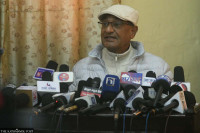National
Nepal and Bangladesh lobby India for corridor to trade electricity
Initially, the two countries want to trade 40-50MW of power via existing transmission infrastructure of India.
Prithvi Man Shrestha
The Nepal Electricity Authority (NEA) says it has sought approval from the Indian authorities to export 40-50 MW of electricity to Bangladesh through India’s existing transmission infrastructure, in line with an agreement reached between Nepal and Bangladesh in August.
The two countries in August last year had decided to request the southern neighbour to allow export of 40-50MW of electricity from Nepal to Bangladesh in the initial phase by utilising the high-voltage Baharampur-Bheramara cross-border power transmission link.
As per the understanding reached during the secretary-level Joint Steering Committee (JSC) formed for Nepal-Bangladesh energy cooperation, the NEA and the Bangladesh Power Development Board would request India’s NTPC Vidyut Vyapar Nigam for a trilateral energy sales and purchase agreement utilising the power line.
In line with the agreement reached with Bangladesh, the NEA has sent a request to the NTPC Vidyut Vyapar Nigam.
“Initially, the Indian company responded that India's existing transmission infrastructure may not have extra capacity to accommodate Nepal’s power to send it to Bangladesh,” said Kul Man Ghising, managing director of the NEA. “We have made a second request to the Indian side and they have responded saying that they would reassess the transmission capacity and respond.”
According to him, informal discussions with the Indian authority continue.
Nepali officials and private sector representatives had raised the issue during a recent interaction with Indian officials in New Delhi when they were taking part in the Power Summit organised by the Confederation of Indian Industries on grid connectivity in the BIMSTEC (Bay of Bengal Initiative for Multi-sectoral Technical and Economic Cooperation) on December 16.
The Nepali side had held discussions with the officials of the Power Grid Corporation of India. “They told us that the Baharampur-Bheramara line is fully occupied and there is no extra capacity to accommodate Nepal’s power through the line,” said Ashish Garg, vice-president of the Independent Power Producers’ Association (IPPAN), who participated in the event.
NEA chief Ghising also confirmed the reply by Indian officials, but said Nepal has requested the Indian side to accommodate an additional 40-50MW in the transmission line that has the capacity to carry 1000MW of electricity.
Alongside Nepal, the Bangladesh government has also asked the Indian authorities to facilitate power trade between the two countries.
During Bangladeshi Prime Minister Sheikh Hasina Wazed’s state visit to India in early September last year, Bangladesh requested that it be allowed to import power from Nepal and Bhutan via India. “The Indian side informed that the guidelines for the same are already in place in India,” a joint statement released after the conclusion of the visit states.
During the bilateral talks on electricity cooperation in New Delhi in the first week of this month, Bangladesh’s State Minister for Power, Energy, and Mineral Resources Nasrul Hamid sought "visible Indian cooperation" for importing hydropower from Nepal and Bhutan, according to a report in The Daily Star, a Bangladeshi newspaper.
The Bangladesh minister notified Indian officials about the rising demand for power in Bangladesh and sought uninterrupted and increased power supply from India. “Although we import 1,160MW of electricity from India, we want to import more," he said, according to the report.
Both India and Bangladesh want to increase the share of renewable energy substantially in the upcoming years. The Indian government has set an ambitious plan to generate 500GW from non-fossil energy-based sources by 2030, meeting 50 percent of energy requirements from renewables.
Likewise, Bangladesh wants to increase the share of renewable energy in the country's power mix to around 40 percent by 2050 from less than three percent now. Water-rich Nepal could help both the countries achieve their dreams, according to officials.
Bangladesh has hence been exploring Nepal’s hydropower to meet its renewable energy targets. It also wants to develop a 683-MW Sunkoshi 3 hydropower project under a joint venture arrangement with Nepal, with the aim of taking power to Bangladesh.
Bangladesh was also negotiating with India’s GMR Group to finalise a power sales agreement to buy 500MW from the 900MW Upper Karnali hydropower project.
However, the project’s case is now in Nepal's Supreme Court, with the apex court first issuing an interim order not to implement the cabinet's decision to give GMR more time to complete the financial closure of the project. In early January, the Supreme Court transferred the dispute to its constitutional bench.
Officials fear the court case would complicate Nepal’s negotiations on exporting power to Bangladesh through India. “With regard to the court’s decision, we are yet to hear the reaction of the Indian government,” said Madhu Bhetuwal, spokesperson at the Ministry of Energy, Water Resource and Irrigation. The Indian company has, however, complained about the situation with the officials of the Investment Board Nepal.
“They [GMR] are complaining as their purchase and sales agreement with a Bangladeshi entity could not take place as planned,” said Amrit Lamsal, spokesperson at Investment Board Nepal.
Lately, a number of Indian companies have shown an interest in developing hydropower projects in Nepal amid positive momentum in creating a common South Asian electricity market, particularly in the sub-region involving Bangladesh, Bhutan, India and Nepal (BBIN).
Nepal and India intend to widen collaboration in the power sector and include partner nations under the BBIN framework, according to the Joint Vision Statement on Power Sector Cooperation between the two countries issued in April of last year.




 15.12°C Kathmandu
15.12°C Kathmandu













%20(1).jpg&w=300&height=200)

